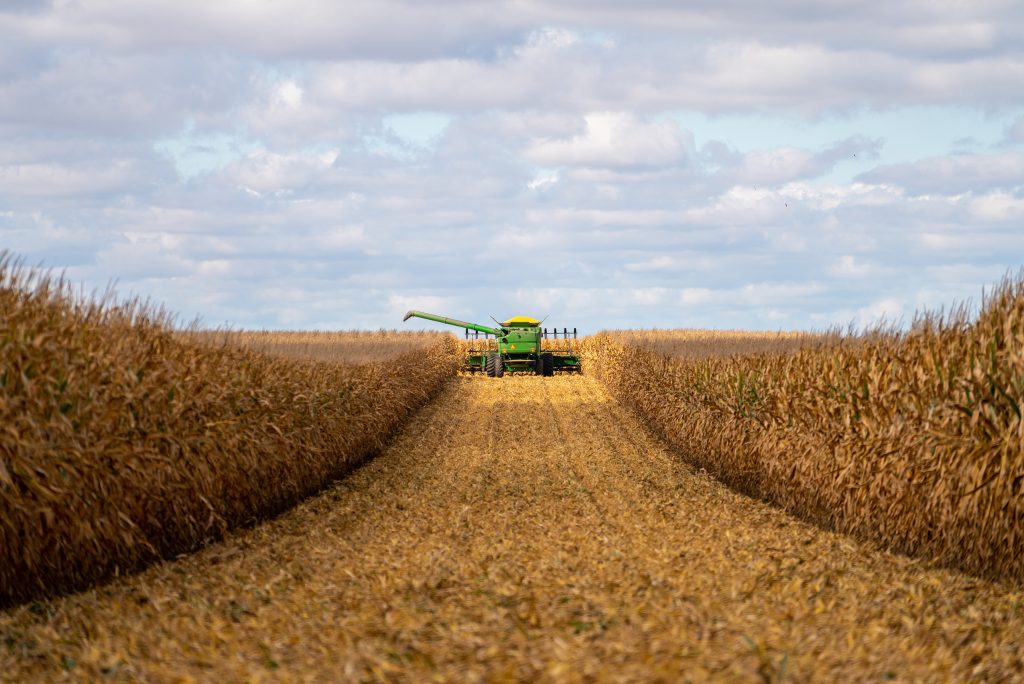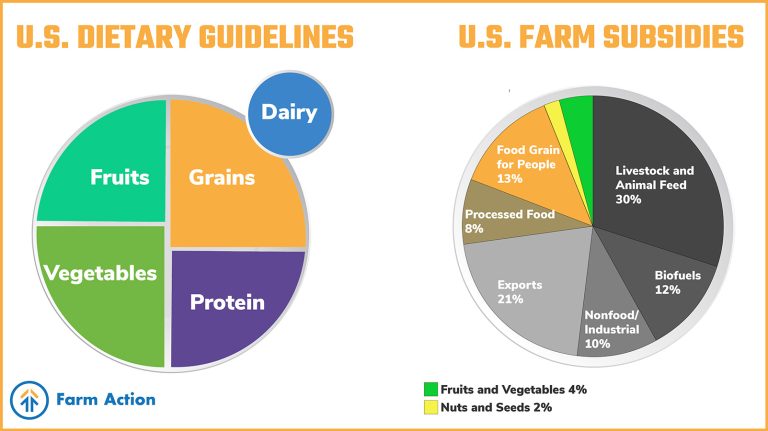Maybe you’ve heard of MyPlate. Maybe you’ve heard of the Food Pyramid. Both are based on federal dietary guidelines: official nutrition recommendations the government issues every five years. If the government is going to be dispensing nutrition advice, you’d think that the foods it recommends would be the same foods that get the most government support, right?
Wrong. There is actually a big, glaring contradiction between the kind of food our government recommends and the kinds of food it supports. The USDA recommends filling 50% of your plate with fruits and vegetables. But in 2019, only 4% of federal farm subsidies supported their production. And while the government recommends that citizens “limit intake of sodium and saturated fats coming from processed meat and poultry,” at the same time it routinely funnels millions toward meatpacking monopolies — instead of supporting regenerative livestock operations through programs like EQIP.
Churning out Cheap Feed and Processed Food
The policies that govern the U.S. food and farm system determine which foods get support for their production through subsidies, or taxpayer-backed financial assistance. Subsidies help keep prices low, so they eventually determine what kind of food will be accessible and affordable to citizens.
Except our subsidies are currently helping out a different group. Currently, the government directs the bulk of its subsidies toward commodity crops like corn and soybeans. These are used to make cheap sugars, starches, and oils that end up in highly-processed junk foods.
Commodity crops also result in industrial livestock feed in a financial mechanism called the “Feed-Meat Complex.” More than a quarter of 2019 farm spending either supported feed for livestock and poultry, or went to the corporate-controlled industrial meat and poultry industries directly.

Cheap industrial livestock feed ultimately benefits meatpacking monopoly corporations, which have for decades wielded their political power to shape a system that suits them — even as it harms Americans.

You Get What You Pay for
You might say our food system isn’t working, but actually it’s doing exactly what it’s designed to do: produce profit for consolidated corporations. In its present form, this system is not designed to make healthy fruits, vegetables, and proteins accessible and affordable to citizens. In fact, the USDA classifies fruits and vegetables as “specialty crops.”
The government’s support for certain foods over others has a major impact on our diets. Because they can be so expensive compared to subsidized food groups, many Americans actually think of fruits, vegetables, and local or regeneratively-raised meat as “luxury items.” Almost 90% of the U.S. population falls below the recommended dietary allowance (RDA) for vegetables, and 80% fall below the RDA for fruit.
How does that compare to foods that receive government support? The average adult American male consumes 75% more protein than he needs, and the average adult American female consumes 50% more. Animal-based foods like meat, eggs, and dairy account for 70-85% of this dietary protein. Half of Americans’ caloric intake comes from ultra-processed foods, made with the starches and sugars derived from corn and soybeans.
It seems clear that subsidies are a major driver of Americans’ diets. When we’re given better access to fruits and vegetables, studies have shown a corresponding increase in consumption.
A National Health and Security Crisis
So what’s the big deal if our subsidies are a bit upside-down compared to our dietary recommendations? Even if the USDA is subsidizing corn and soybeans instead of produce, we as Americans have the freedom to buy fruits and vegetables if we want them, right?
Well, sort of. As a country, we’ve gotten ourselves into a precarious situation: our farm system only produces about 25% of the dietary fiber our population needs, so we have to import two thirds of our fresh fruit and one third of our fresh vegetables. And so even if that 80 – 90% of Americans who aren’t eating enough fruits and vegetables suddenly transformed their diets, our current food system would be unable to meet the demand.
This reliance on imported food is actually a pretty big national security issue.

The U.S. isn’t currently producing enough of the necessary nutrients to keep its citizens healthy, and is instead dependent on other countries. This leaves us vulnerable to trade dynamics, extreme weather events, and other global events well beyond our control — and if the COVID-19 pandemic taught us anything, it’s that preparedness and resilience are key to survival.
Eating the food that the government subsidizes is also taking a toll on our health: more than 10% of us have diabetes, and more than 40% are classified as obese. Obesity-related illnesses like heart disease, stroke, type 2 diabetes, and certain types of cancer are the leading causes of preventable premature death. The estimated medical cost of obesity in the U.S. was nearly $173 billion in 2019, and medical costs for adults who had obesity were on average $1,861 higher than medical costs for people with healthy weights. In 2018, national health expenditures were $3.6 trillion and are projected to nearly double to $6.2 trillion by 2028. To the critics who say we can’t afford to address this issue, we’d respond that the country cannot afford to leave this epidemic untreated.
By and large, farmers do what they do because they want to feed people: their families, their neighbors, their country. But our food subsidies — which many farmers need in order to stay financially afloat — have them instead fattening up cows, pigs, and chickens in order to feed the pockets of JBS and Smithfield.

So What Can Be Done About This?
The 2023 Farm Bill is a fast-approaching opportunity to shift support away from commodity crops that feed industrial livestock and toward the production of food that feeds people. We call this principle “Food, Not Feed,” and it’s an essential pillar of our Fair Farm Bill campaign. Directing federal farm subsidies toward the production of fiber-rich foods and regeneratively-raised animal proteins will help to create a U.S. food and farm system that’s fair and equitable from seed to fork.
There is already support for this eater- and farmer-focused framework among members of the House and Senate Agriculture Committees. For example, Senator Booker’s Farm System Reform Act would rein in the industrial factory farm model, reverse the trend of lost land and livelihoods, and restore prosperity to rural farming communities. The Senator’s lead food policy staff has also publicly called for “aligning our public investments with the outcomes we want to see.” Policy changes like these would give farmers the autonomy and support they need to escape the treadmill of industrial agriculture and profitably grow food for their communities.
With greater support for nutritious, locally-produced food, we can have a healthier food system, and a healthier population. And our farmers will win, they will get to do what they do best: feed their neighbors and communities. We hope you’ll join in!
Written and designed by Dee Laninga; edited by Angela Huffman and Joe Maxwell; research by Sarah Carden, Angela Huffman, and Joe Maxwell; concept by Angela Huffman.


